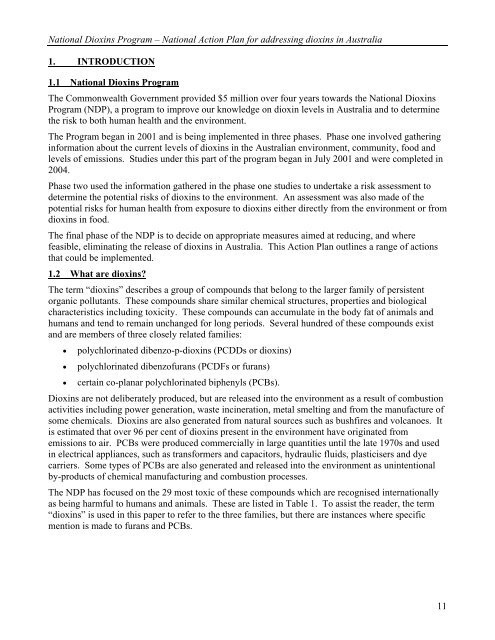National Action Plan for Addressing Dioxins in Australia
National Action Plan for Addressing Dioxins in Australia
National Action Plan for Addressing Dioxins in Australia
- No tags were found...
Create successful ePaper yourself
Turn your PDF publications into a flip-book with our unique Google optimized e-Paper software.
<strong>National</strong> <strong>Diox<strong>in</strong>s</strong> Program – <strong>National</strong> <strong>Action</strong> <strong>Plan</strong> <strong>for</strong> address<strong>in</strong>g diox<strong>in</strong>s <strong>in</strong> <strong>Australia</strong>1. INTRODUCTION1.1 <strong>National</strong> <strong>Diox<strong>in</strong>s</strong> ProgramThe Commonwealth Government provided $5 million over four years towards the <strong>National</strong> <strong>Diox<strong>in</strong>s</strong>Program (NDP), a program to improve our knowledge on diox<strong>in</strong> levels <strong>in</strong> <strong>Australia</strong> and to determ<strong>in</strong>ethe risk to both human health and the environment.The Program began <strong>in</strong> 2001 and is be<strong>in</strong>g implemented <strong>in</strong> three phases. Phase one <strong>in</strong>volved gather<strong>in</strong>g<strong>in</strong><strong>for</strong>mation about the current levels of diox<strong>in</strong>s <strong>in</strong> the <strong>Australia</strong>n environment, community, food andlevels of emissions. Studies under this part of the program began <strong>in</strong> July 2001 and were completed <strong>in</strong>2004.Phase two used the <strong>in</strong><strong>for</strong>mation gathered <strong>in</strong> the phase one studies to undertake a risk assessment todeterm<strong>in</strong>e the potential risks of diox<strong>in</strong>s to the environment. An assessment was also made of thepotential risks <strong>for</strong> human health from exposure to diox<strong>in</strong>s either directly from the environment or fromdiox<strong>in</strong>s <strong>in</strong> food.The f<strong>in</strong>al phase of the NDP is to decide on appropriate measures aimed at reduc<strong>in</strong>g, and wherefeasible, elim<strong>in</strong>at<strong>in</strong>g the release of diox<strong>in</strong>s <strong>in</strong> <strong>Australia</strong>. This <strong>Action</strong> <strong>Plan</strong> outl<strong>in</strong>es a range of actionsthat could be implemented.1.2 What are diox<strong>in</strong>s?The term “diox<strong>in</strong>s” describes a group of compounds that belong to the larger family of persistentorganic pollutants. These compounds share similar chemical structures, properties and biologicalcharacteristics <strong>in</strong>clud<strong>in</strong>g toxicity. These compounds can accumulate <strong>in</strong> the body fat of animals andhumans and tend to rema<strong>in</strong> unchanged <strong>for</strong> long periods. Several hundred of these compounds existand are members of three closely related families:• polychlor<strong>in</strong>ated dibenzo-p-diox<strong>in</strong>s (PCDDs or diox<strong>in</strong>s)• polychlor<strong>in</strong>ated dibenzofurans (PCDFs or furans)• certa<strong>in</strong> co-planar polychlor<strong>in</strong>ated biphenyls (PCBs).<strong>Diox<strong>in</strong>s</strong> are not deliberately produced, but are released <strong>in</strong>to the environment as a result of combustionactivities <strong>in</strong>clud<strong>in</strong>g power generation, waste <strong>in</strong>c<strong>in</strong>eration, metal smelt<strong>in</strong>g and from the manufacture ofsome chemicals. <strong>Diox<strong>in</strong>s</strong> are also generated from natural sources such as bushfires and volcanoes. Itis estimated that over 96 per cent of diox<strong>in</strong>s present <strong>in</strong> the environment have orig<strong>in</strong>ated fromemissions to air. PCBs were produced commercially <strong>in</strong> large quantities until the late 1970s and used<strong>in</strong> electrical appliances, such as trans<strong>for</strong>mers and capacitors, hydraulic fluids, plasticisers and dyecarriers. Some types of PCBs are also generated and released <strong>in</strong>to the environment as un<strong>in</strong>tentionalby-products of chemical manufactur<strong>in</strong>g and combustion processes.The NDP has focused on the 29 most toxic of these compounds which are recognised <strong>in</strong>ternationallyas be<strong>in</strong>g harmful to humans and animals. These are listed <strong>in</strong> Table 1. To assist the reader, the term“diox<strong>in</strong>s” is used <strong>in</strong> this paper to refer to the three families, but there are <strong>in</strong>stances where specificmention is made to furans and PCBs.11
















